
Norwegian Offshore Rental strengthening quality with RamBase QMS
RamBase
Table of contents
Since its founding in 2005, Norwegian Offshore Rental (NOR) has been dedicated to supporting the offshore, subsea, and renewable industries. Initially focused on ship management and personnel supply for the shipbuilding industry, the company shifted its focus in 2011 to specialize in equipment rental. Today, NOR is a key provider of rental equipment in the North Sea region and other major oil and gas markets. In line with its mission to prioritize safety, quality, and sustainability, NOR has integrated the RamBase Quality Management System into its operations.
Norwegian Offshore Rental envisions a world where the offshore, sub-sea, and renewable sectors share a common pool of cutting-edge equipment to create a more efficient, cost-effective, and sustainable future. This vision aligns perfectly with NOR’s operational focus—investing in top-tier equipment, providing excellent customer service, and building long-lasting customer relationships.
By implementing RamBase Quality Management System (QMS), NOR is taking a proactive step to ensure they continue meeting their customers' stringent safety and quality requirements. Tore Gautesen, CEO at Norwegian Offshore Rental, shares his perspective on the implementation:
"As a company dedicated to providing top-tier rental solutions, we are committed to delivering the safest, most reliable, and highest-quality rental solutions to our customers. We are excited to implement RamBase QMS, a system that will enable us to elevate the quality of our processes, enhance our HSE performance, and facilitate for continuous improvement"
Why RamBase QMS?
NOR’s operations require meticulous oversight of equipment, personnel, and processes to ensure safety and compliance in a demanding industry. With a growing rental pool of specialized equipment—ranging from lifting gear and ROV tools to buoyancy aids and subsea video inspection tools—the company needed a quality management solution that would simplify documentation, standardize procedures, and ensure compliance with industry regulations.
Ingunn Nordbø, HSEQ Manager at Norwegian Offshore Rental, highlights the reasoning behind their choice:
"We required a system capable of supporting the development of an effective management framework, with HSEQ seamlessly integrated across all elements of our business. After assessing several systems based on predefined criteria, we determined that RamBase QMS was the most suitable option. We are confident that the system is user-friendly, adaptable, and scalable, and it encompasses all the essential functionalities needed to help us achieve our ambitious organizational goals."
Øivind Aasland Håkonsen, Sales Manager at RamBase, also emphasizes the perfect match between the two companies
"NOR is a perfect fit for RamBase QMS. They are a company with a substantial focus on safeguarding their employees and ensuring the quality of their operations. Their equipment and customer demands require a robust system to manage safety and quality, and we’re thrilled to support them in achieving these goals"
A Partnership for growth and quality
We are proud to welcome Norwegian Offshore Rental as a new RamBase customer. Their dedication to safety, quality, and sustainability is well supported by what RamBase delivers: tools for streamlining processes, enhance compliance, and building a culture for continuous improvements.
If your company is looking for help to meet the highest standards of safety and quality, contact us today to learn how RamBase QMS can make a difference.
Comments (0)
No comments here yet, start first!
Leave your comment
You may also read:
From coat to full control – five levels for better financial management
RamBase
